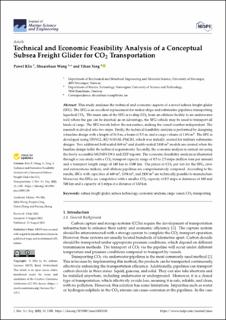| dc.contributor.author | Klis, Pawel Janusz | |
| dc.contributor.author | Wang, Shuaishuai | |
| dc.contributor.author | Xing, Yihan | |
| dc.date.accessioned | 2022-12-20T11:35:16Z | |
| dc.date.available | 2022-12-20T11:35:16Z | |
| dc.date.created | 2022-08-08T13:00:39Z | |
| dc.date.issued | 2022-08 | |
| dc.identifier.citation | Klis, P., Wang, S., & Xing, Y. (2022). Technical and Economic Feasibility Analysis of a Conceptual Subsea Freight Glider for CO2 Transportation. Journal of Marine Science and Engineering, 10(8), 1108. | en_US |
| dc.identifier.issn | 2077-1312 | |
| dc.identifier.uri | https://hdl.handle.net/11250/3038796 | |
| dc.description.abstract | This study analyses the technical and economic aspects of a novel subsea freight glider (SFG). The SFG is an excellent replacement for tanker ships and submarine pipelines transporting liquefied CO2. The main aim of the SFG is to ship CO2 from an offshore facility to an underwater well where the gas can be injected; as an advantage, the SFG vehicle may be used to transport all kinds of cargo. The SFG travels below the sea surface, making the vessel weather-independent. The research is divided into two steps. Firstly, the technical feasibility analysis is performed by designing a baseline design with a length of 56.5 m, a beam of 5.5 m, and a cargo volume of 1194 m3. The SFG is developed using DNVGL-RU-NAVAL-Pt4Ch1, which was initially created for military submarine designs. Two additional half-scaled 469 m3 and double-scaled 2430 m3 models are created when the baseline design fulfils the technical requirements. Secondly, the economic analysis is carried out using the freely accessible MUNIN D9.3 and ZEP reports. The economic feasibility analysis is illustrated through a case study with a CO2 transport capacity range of 0.5 to 2.5 mtpa (million tons per annum) and a transport length range of 180 km to 1500 km. The prices of CO2 per ton for the SFG, crew and autonomous tankers, and offshore pipelines are comprehensively compared. According to the results, SFGs with capacities of 469 m3, 1194 m3, and 2430 m3 are technically possible to manufacture. Moreover, the SFGs are competitive with a smaller CO2 capacity of 0.5 mtpa at distances of 180 and 500 km and a capacity of 1 mtpa at a distance of 180 km. | en_US |
| dc.language.iso | eng | en_US |
| dc.publisher | MDPI | en_US |
| dc.rights | Navngivelse 4.0 Internasjonal | * |
| dc.rights.uri | http://creativecommons.org/licenses/by/4.0/deed.no | * |
| dc.subject | marin teknologi | en_US |
| dc.subject | undervannsteknologi | en_US |
| dc.subject | marine science | en_US |
| dc.subject | subsea technology | en_US |
| dc.title | Technical and Economic Feasibility Analysis of a Conceptual Subsea Freight Glider for CO2 Transportation | en_US |
| dc.type | Peer reviewed | en_US |
| dc.type | Journal article | en_US |
| dc.description.version | publishedVersion | en_US |
| dc.rights.holder | ©2022 by the authors | en_US |
| dc.subject.nsi | VDP::Teknologi: 500::Marin teknologi: 580 | en_US |
| dc.source.volume | 10 | en_US |
| dc.source.journal | Journal of Marine Science and Engineering | en_US |
| dc.source.issue | 8 | en_US |
| dc.identifier.doi | 10.3390/jmse10081108 | |
| dc.identifier.cristin | 2041719 | |
| dc.source.articlenumber | 1108 | en_US |
| cristin.ispublished | true | |
| cristin.fulltext | postprint | |
| cristin.qualitycode | 1 | |

